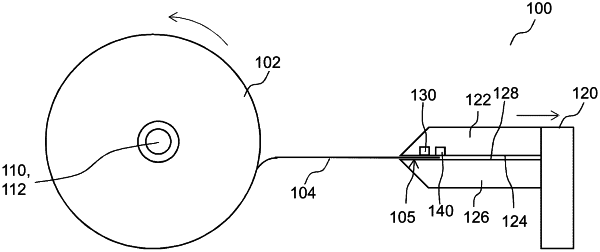| CPC B29D 11/00432 (2013.01) [B29C 39/22 (2013.01); B29D 11/00413 (2013.01); B29L 2011/0016 (2013.01)] | 20 Claims |

|
1. A de-taping machine for removing a tape around a perimeter of a lens-mold-assembly, the machine comprising:
a lens-mold-assembly-rotation mechanism having a first rotary part and a second rotary part coaxially aligned, the first rotary part and the second rotary part being operable to be axially spaced from each other along a common axis for holding the lens-mold-assembly therebetween, each of the first rotary part and the second rotary part being rotatable about the common axis; and
a tape gripping mechanism comprising
a first jaw disposed at a radial position from the common axis, the first jaw having a clamping surface,
a second jaw movable towards the first jaw to perform a clamping action for clamping a free end of the tape around the perimeter of the lens-mold-assembly aligned to the tape gripping mechanism,
a proximity sensing arrangement disposed on the first jaw and configured to generate a first detection signal when the free end of the tape is detected at a pre-determined distance from the first jaw, and
a contact sensing arrangement disposed on the clamping surface of the first jaw and configured to generate a second detection signal when the free end of the tape is in contact with the clamping surface of the first jaw,
wherein the lens-mold-assembly-rotation mechanism is configured to vary a rotational speed of the first rotary part and the second rotary part based on the first detection signal from the proximity sensing arrangement,
wherein the lens-mold-assembly-rotation mechanism is configured to stop the first rotary part and the second rotary part from rotating and the tape gripping mechanism is configured to move the second jaw towards the first jaw to perform the clamping action based on the second detection signal from the contact sensing arrangement.
|